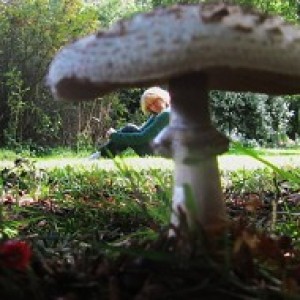Desert Island Discs 7
Desert Island Discs Day 7.
So, one day a hunter sat down with some wood some glue and some tools, and created a box with a hole in one side, he tapped it with his knuckle.
'Hmm', he thought. 'That's quite a good sound, but I can improve on it.'
'I'll get some intestine from a cow, scrape it, stretch and twist it into a thread while it's drying.
Then, I'll fix four lengths of the cattle-gut thread across the hole on the box.'
He plucked the thread with his finger and it made a sound that resonated through the box.
'Ahhh,' he thought. 'That's a good sound, but how can I make the notes higher or lower?'
'I know! I'll add a stick to one end of the box and have twisting knobs at different points along it. Then I can have four threads and adjust their length and tension.'
'Result! Different notes, now I can make tunes.'
One day he went hunting for deer, as he lifted his long bow, the string of the bow caught on the threads on his box instrument and made a sound that lasted much longer than when he plucked the threads.
He tried again, but the bow string slipped... This required further thought.
'I know, I'll gather some sticky sap from a pine tree and mix it with bees wax, then rub it onto the bowstring to prevent it slipping. It worked, but the sound produced was quite harsh.'
He thought again.
'What if I get some rare wood from the Amazon rain forest and carve it into a long, slightly curved shape. Then, I'll get some white horse tail hairs - about 150, from a harsh climate like Mongolia and attach them to the wood at one end. At the other end I'll carve a small intricate piece of wood and abalone shell which I shall call a frog. I'll make the frog move along the piece of wood, that I shall call a bow, so the horsehair can be tensioned. I'll rub my beeswax and sap mix, that I've called rosin, onto the horsehair to create resistance.'
He sat with the box across his lap and drew the bow with the horsehair across the cattle-gut thread that he now called strings, and the result was astonishingly good. But his two hands were not sufficient to keep the instrument still, draw the bow, and change the length of the strings with his fingers.
He tucked the end of the box under his chin, the stick end naturally fell into the palm of his left hand, leaving his fingers free to hold down the strings at any point along the stick. He took the bow in his right hand and drew it back and forth across one string. By changing the angle of his right hand the bow could be drawn across each string separately. This gave a huge range of notes that could be played on the instrument.
Many, many years later a bloke from Germany, called Max, decided to write a concerto specifically for the instrument described above, and this is the result.
I wanted to include a piece of classical music in my eight discs, even though my repertoire and knowledge is limited pretty much to the popular classics.
I will miss the English seasons on a desert island, each has its merits and I love them all, so I was very tempted to select Vivaldi's Four Seasons, but then I played this and the memories came flooding back.
I remember so clearly the first time I heard this piece of music. I'd been playing darts in the pub and was invited back to friends' for coffee. Chris put this on and it blew me away.
Max Bruch's Violin concerto in G minor ops 26, was first completed in 1866, but then considerably revised and the present form was first played in 1868.
For me, the first and third movements are wonderfully uplifting, but I have chosen the Adagio (2nd movement) for its hauntingly melancholy tune.
This is for the days on the island when tears are inevitable.
- 1
- 1
- Canon PowerShot SX210 IS
- 1/33
- f/3.1
- 5mm
- 640

Comments
Sign in or get an account to comment.


